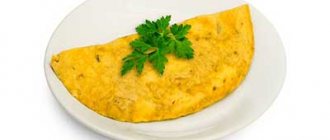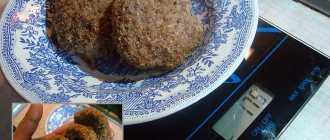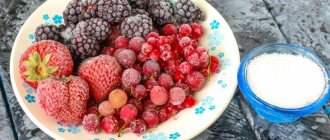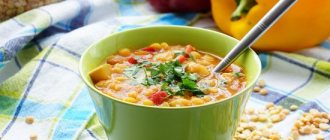Recipe: Omelette
1 serving 150 grams
Cooking technology: before preparing an omelet, eggs must be washed to remove dirt and dust. Milk and salt are added to the prepared egg mass. To get a beautiful, fluffy omelette, you must follow the ratio of 1 egg (40 g), 15 g of milk and 0.5 g of salt. The mixture is thoroughly stirred and poured onto a greased baking sheet. Then the container with the omelette mixture is placed in the oven and baked at a temperature of 180-200°C until cooked.
You can also fry the omelette in a frying pan in the form of an oval pie. The egg mixture for the omelette is poured into a heated frying pan with melted butter, the mixture is stirred until it begins to thicken, then the edges of the omelette are folded with a knife from both sides towards the middle, giving the dish an oblong shape.
When serving, pour melted butter over the omelet.
How to reduce the calorie content of an omelet?
A low-calorie omelette can be obtained by eliminating oil from its composition. But you need to understand that in this case it should be cooked in one of the following ways:
- in the oven;
- in a slow cooker;
- in a steamer;
- in the microwave.
Or you can use a regular package. To do this, pour a beaten mass of 3 eggs and 150 ml of milk into a bag and tie it tightly. For reliability, the resulting bag is placed in another one, also tied well. Pour 1 liter of water into a saucepan and place on fire. Gradually lower the bag into boiling water. Cook the mixture over low heat for 25 minutes. The calorie content of the dish will be 85 kcal.
Another way to reduce the fat content of an omelet is to make it with only whites and replace the milk with water. If you can’t give up yolks, then reduce the number of eggs altogether. For example, instead of 2 eggs, take one and replace the second with vegetables and herbs. Use dill, basil, parsley. For true gourmets, oregano, cilantro, rosemary or celery are suitable.
Directions
Omelette
IngredientsDirections
Table 1
| Products | Weight | Squirrels | Fats | Carbohydrates |
| Chicken egg | 120 gr | 15.24 | 13.8 | 0.84 |
| Pasteurized milk 2.5% fat | 45 ml | 1.31 | 1.13 | 2.16 |
| Butter 82.5% fat, traditional | 10 g | 0.05 | 8.25 | 0.08 |
| Salt | 1 g | 0 | 0 | 0 |
| Exit | 150 | 16.6 | 23.18 | 3.08 |
Popular recipes
With greens
You will need the following products:
- 2 chicken eggs;
- 150 milliliters of fat milk;
- salt and spices to taste (paprika or ground red pepper will do);
- fresh herbs (you can use dill, parsley, cilantro, green onions).
For lovers of spicy food, it is recommended to add ground or fresh chopped garlic.
You need to take a bowl or prepare a multicooker bowl, add all the elements of the future dish and mix or beat thoroughly. The omelette is prepared at medium temperature for about 20-25 minutes. If you use a frying pan, you must cover it with a lid on top. There is no need to stir the mixture or turn over during the process.
With tomatoes and cheese
Ingredients:
- 2 chicken eggs;
- 150 milliliters of milk (any fat content);
- salt to taste;
- 2 tomatoes (can be cherry);
- hard cheese (you can use processed cheese without preservatives or harmful additives).
All elements are mixed together (either by hand or using mechanical kitchen equipment) and poured into a frying pan or other container. Cooking temperature - 160-170 degrees. Time - 25 minutes.
With bacon
Scrambled eggs or scrambled eggs with bacon are a favorite breakfast of citizens in many countries around the world.
Pieces of bacon of different lengths and shapes are added to the classic recipe. It can be put raw, roasted, smoked and dried. With bacon, the dish turns out to be very filling and high in calories. It has an incredible smell and specific taste.
With mushrooms and spices
You will need:
- 2 chicken eggs;
- 150 milliliters of milk (preferably full-fat);
- salt to taste;
- fresh or frozen mushrooms (porcini, champignons, honey mushrooms or chanterelles);
- oregano;
- red and black pepper;
- paprika.
All ingredients must be thoroughly beaten or stirred with a whisk. Pour into a mold or frying pan and cook at 160-170 degrees for 25-30 minutes. Dried mushrooms can also be used in this recipe. They need to be soaked 1-2 days before starting to prepare the omelet.
Using egg powder
Sometimes, to obtain a fluffy and beautiful omelette, egg powder is added to the standard (classic) composition of products. It has a yellowish tint and a crumbly structure.
When adding it in an amount of 50-70 grams of water, the mixture will increase under the influence of high temperature. As a result, it rises and resembles a pie.
With sweet pepper and cheese
For this dietary and healthy dish you will need:
- 2 eggs;
- 150 milliliters of milk;
- table salt;
- 1 medium-sized sweet pepper;
- 60-80 grams of cheese.
It is recommended to first mix the eggs with milk and salt, pour the mixture into a mold or frying pan at medium temperature. Cut the cheese into small cubes, wash the pepper thoroughly, core it and cut it into cubes.
While the omelette is ripening, you need to add pepper and cheese pieces to it. The finished dish has a delicate and pleasant aroma that evokes appetite. Additional products play an important role here, as they contain a useful vitamin and mineral complex.
Calculation of the calorie content of the recipe per 150 grams
The calculation of the calorie content of 150 grams of the recipe is based on the summarized indicators of BZhUK (abbreviation: proteins-fats-carbohydrates-acids) of the ingredients from table (1) involved in the preparation. The data was taken from the database of the “products” section of the website and brought into line with the final yield of the dish (net).
Our example involves proteins - 16.6 grams, fats - 23.18 grams and carbohydrates - 3.08 grams, contained in 150 grams of the recipe. Next we perform the calculation:
Energy value of 150 grams of recipe = 16.6 (proteins)*4 + 23.18 (fat)*9 + 3.08 (carbohydrates)*4 = 66.4 + 208.62 + 12.32 = 287.3 kcal
Fried omelette recipe. Calorie, chemical composition and nutritional value.
Nutritional value and chemical composition of “Fried Omelette”.
The table shows the nutritional content (calories, proteins, fats, carbohydrates, vitamins and minerals) per 100 grams of edible portion.
| Nutrient | Quantity | Norm** | % of the norm in 100 g | % of the norm in 100 kcal | 100% normal |
| Calorie content | 176.2 kcal | 1684 kcal | 10.5% | 6% | 956 g |
| Squirrels | 8.9 g | 76 g | 11.7% | 6.6% | 854 g |
| Fats | 8.5 g | 56 g | 15.2% | 8.6% | 659 g |
| Carbohydrates | 15.9 g | 219 g | 7.3% | 4.1% | 1377 g |
| Alimentary fiber | 0.7 g | 20 g | 3.5% | 2% | 2857 g |
| Water | 68.5 g | 2273 g | 3% | 1.7% | 3318 g |
| Ash | 0.869 g | ~ | |||
| Vitamins | |||||
| Vitamin A, RE | 127.7 mcg | 900 mcg | 14.2% | 8.1% | 705 g |
| Retinol | 0.11 mg | ~ | |||
| beta carotene | 0.029 mg | 5 mg | 0.6% | 0.3% | 17241 g |
| Vitamin B1, thiamine | 0.078 mg | 1.5 mg | 5.2% | 3% | 1923 |
| Vitamin B2, riboflavin | 0.274 mg | 1.8 mg | 15.2% | 8.6% | 657 g |
| Vitamin B4, choline | 134.93 mg | 500 mg | 27% | 15.3% | 371 g |
| Vitamin B5, pantothenic | 0.828 mg | 5 mg | 16.6% | 9.4% | 604 g |
| Vitamin B6, pyridoxine | 0.121 mg | 2 mg | 6.1% | 3.5% | 1653 g |
| Vitamin B9, folates | 11.02 mcg | 400 mcg | 2.8% | 1.6% | 3630 g |
| Vitamin B12, cobalamin | 0.426 mcg | 3 mcg | 14.2% | 8.1% | 704 g |
| Vitamin C, ascorbic acid | 0.47 mg | 90 mg | 0.5% | 0.3% | 19149 g |
| Vitamin D, calciferol | 1.015 mcg | 10 mcg | 10.2% | 5.8% | 985 g |
| Vitamin E, alpha tocopherol, TE | 1.606 mg | 15 mg | 10.7% | 6.1% | 934 g |
| Vitamin H, biotin | 11.04 mcg | 50 mcg | 22.1% | 12.5% | 453 g |
| Vitamin K, phylloquinone | 0.1 mcg | 120 mcg | 0.1% | 0.1% | 120000 g |
| Vitamin RR, NE | 2.5774 mg | 20 mg | 12.9% | 7.3% | 776 g |
| Niacin | 0.353 mg | ~ | |||
| Macronutrients | |||||
| Potassium, K | 156.65 mg | 2500 mg | 6.3% | 3.6% | 1596 g |
| Calcium, Ca | 81.14 mg | 1000 mg | 8.1% | 4.6% | 1232 g |
| Silicon, Si | 0.808 mg | 30 mg | 2.7% | 1.5% | 3713 g |
| Magnesium, Mg | 14.54 mg | 400 mg | 3.6% | 2% | 2751 g |
| Sodium, Na | 84.92 mg | 1300 mg | 6.5% | 3.7% | 1531 g |
| Sera, S | 107.34 mg | 1000 mg | 10.7% | 6.1% | 932 g |
| Phosphorus, P | 144.2 mg | 800 mg | 18% | 10.2% | 555 g |
| Chlorine, Cl | 127.02 mg | 2300 mg | 5.5% | 3.1% | 1811 |
| Microelements | |||||
| Aluminium, Al | 235.9 mcg | ~ | |||
| Bor, B | 7.5 mcg | ~ | |||
| Vanadium, V | 18.17 mcg | ~ | |||
| Iron, Fe | 1.403 mg | 18 mg | 7.8% | 4.4% | 1283 g |
| Yod, I | 13.63 mcg | 150 mcg | 9.1% | 5.2% | 1101 g |
| Cobalt, Co | 5.213 mcg | 10 mcg | 52.1% | 29.6% | 192 g |
| Manganese, Mn | 0.131 mg | 2 mg | 6.6% | 3.7% | 1527 g |
| Copper, Cu | 63.34 mcg | 1000 mcg | 6.3% | 3.6% | 1579 g |
| Molybdenum, Mo | 7.622 mcg | 70 mcg | 10.9% | 6.2% | 918 g |
| Nickel, Ni | 0.444 mcg | ~ | |||
| Tin, Sn | 7.28 mcg | ~ | |||
| Selenium, Se | 16.456 mcg | 55 mcg | 29.9% | 17% | 334 g |
| Strontium, Sr | 8.14 mcg | ~ | |||
| Titanium, Ti | 2.22 mcg | ~ | |||
| Fluorine, F | 38.81 mcg | 4000 mcg | 1% | 0.6% | 10307 g |
| Chromium, Cr | 3.2 mcg | 50 mcg | 6.4% | 3.6% | 1563 g |
| Zinc, Zn | 0.8331 mg | 12 mg | 6.9% | 3.9% | 1440 g |
| Digestible carbohydrates | |||||
| Starch and dextrins | 13.158 g | ~ | |||
| Mono- and disaccharides (sugars) | 2.8 g | max 100 g | |||
| Essential amino acids | |||||
| Arginine* | 0.356 g | ~ | |||
| Valin | 0.347 g | ~ | |||
| Histidine* | 0.153 g | ~ | |||
| Isoleucine | 0.27 g | ~ | |||
| Leucine | 0.487 g | ~ | |||
| Lysine | 0.406 g | ~ | |||
| Methionine | 0.189 g | ~ | |||
| Methionine + Cysteine | 0.325 g | ~ | |||
| Threonine | 0.275 g | ~ | |||
| Tryptophan | 0.09 g | ~ | |||
| Phenylalanine | 0.293 g | ~ | |||
| Phenylalanine+Tyrosine | 0.509 g | ~ | |||
| Nonessential amino acids | |||||
| Alanin | 0.32 g | ~ | |||
| Aspartic acid | 0.554 g | ~ | |||
| Glycine | 0.189 g | ~ | |||
| Glutamic acid | 0.798 g | ~ | |||
| Proline | 0.18 g | ~ | |||
| Serin | 0.419 g | ~ | |||
| Tyrosine | 0.216 g | ~ | |||
| Cysteine | 0.131 g | ~ | |||
| Sterols (sterols) | |||||
| Cholesterol | 260.73 mg | max 300 mg | |||
| beta sitosterol | 4.695 mg | ~ | |||
| Saturated fatty acids | |||||
| Saturated fatty acids | 2.5 g | max 18.7 g | |||
| 14:0 Miristinovaya | 0.018 g | ~ | |||
| 15:0 Pentadecane | 0.005 g | ~ | |||
| 16:0 Palmitinaya | 1.069 g | ~ | |||
| 17:0 Margarine | 0.014 g | ~ | |||
| 18:0 Stearic | 0.493 g | ~ | |||
| 20:0 Arakhinovaya | 0.021 g | ~ | |||
| 22:0 Begenovaya | 0.016 g | ~ | |||
| Monounsaturated fatty acids | 2.799 g | min 16.8 g | 16.7% | 9.5% | |
| 16:1 Palmitoleic | 0.176 g | ~ | |||
| 17:1 Heptadecene | 0.005 g | ~ | |||
| 18:1 Oleic (omega-9) | 2.4 g | ~ | |||
| 20:1 Gadoleic (omega-9) | 0.018 g | ~ | |||
| Polyunsaturated fatty acids | 1.972 g | from 11.2 to 20.6 g | 17.6% | 10% | |
| 18:2 Linolevaya | 1.9 g | ~ | |||
| 18:3 Linolenic | 0.027 g | ~ | |||
| 20:4 Arachidonic | 0.045 g | ~ | |||
| Omega-6 fatty acids | 0.5 g | from 4.7 to 16.8 g | 10.6% | 6% |
The energy value of fried omelette is 176.2 kcal.
Primary Source: Created in the application by the user. Read more.
** This table shows the average levels of vitamins and minerals for an adult. If you want to know the norms taking into account your gender, age and other factors, then use the “My Healthy Diet” application.
Calorie calculation for 100 grams
As an example, we will calculate a portion equal to 100 grams - this is one of the standard weight measures that determines the total calorie content of a product or recipe.
The easiest and most versatile option (suitable for calculating any volume of a product or ready-made dish) is the calculation by multiplying the resulting calorie content (150 grams) by a factor of 0.67, which is the result of division (100 g / 150 g).
Calorie content of 100 grams of serving = 287.3 * 0.67 = 192 kcal.
In addition, in the same way you can calculate the content of BZHU in the composition of a portion:
- Protein = 16.6 * 0.67 = 11.122 ≈ 11.1 g.
- Fat = 23.18 * 0.67 = 15.5306 ≈ 15.5 g.
- Carbohydrates = 3.08 * 0.67 = 2.0636 ≈ 2.1 g.
11.1 * 4 + 15.5 * 9 + 8.4 * 4 ≈ 192 kcal
Our calculated calorie content is more than 50, but less than 250 kcal, which means that an omelette is a medium-calorie dish with a high content of proteins, fats and low carbohydrates.
Ways to reduce the calorie content of an omelet
- We prepare the product using household appliances. An omelet in a slow cooker or double boiler has slightly fewer calories. Naturally, such an omelette will not have the delicious crust that many people love;
- We reduce the number of eggs in the omelet to a reasonable limit and add various vegetables, herbs, do not use mayonnaise and ketchup;
- We prepare the omelette without yolks, using high-quality water (melt). Any lazy person who has a refrigerator with a freezer can prepare melt water;
- We prepare an omelette without using any oil (even the “favorite” of all nutritionists, olive oil).
Vitamin content
table 2
| Vitamins | Content | Daily norm |
| C (ascorbic acid) | 0.18 mg | 0.3 % |
| A (retinol) | 255.81 mcg | 25.6 % |
| E (α-, β-, γ-tocopherols) | 0.55 mg | 5.5 % |
| D (lamisterol) | 1.88 mcg | 75.1 % |
| B1 (thiamine) | 0.06 mg | 4.2 % |
| B2 (riboflavin) | 0.4 mg | 22.2 % |
| B3 (PP) (nicotinamide) | 3.15 mg | 16.6 % |
| B4 (choline) | 207.83 mg | 41.6 % |
| B6 (pyridoxine) | 0.12 mcg | 6 % |
| B9 (folacin) | 6.53 mcg | 3.3 % |
| B12 (cobalamin) | 0.48 mcg | 16 % |
Omelette contains vitamins with high, medium and low levels when considered according to the approved standards for the nutritional value of the dish.
At the highest level of importance in the food value chain are:
- A, takes part in all functions of the body related to its growth and proper metabolism, preserves the structure of the cornea of the eye.
- D, takes part in the formation of bone and dental tissue.
- B2, maintains body tone.
- PP, participates in the formation of hemoglobin.
- B4, is involved in the biosynthesis of heme and proteins, cell proliferation, and tissue respiration.
- B12 is involved in many metabolic processes in the body.
Vitamins at a medium level of importance include:
- E, keeps the muscular system in good shape.
- B6, participates in the metabolism of lipids and amino acids.
Vitamins of low content include:
- C, takes part in the redox processes of the body, raises the tone of the body, strengthens the immune system.
- B1, required to normalize the nervous and muscular systems.
- B9, supports the hematopoietic and digestive system.
How many calories are in an omelet without butter?
Calorie content of 100 grams of various oils with which most people prepare omelettes:
- Olive – 198 kcal;
- Sunflower – 578 kcal;
- Creamy – 748 kcal;
- Peanut and corn - 899 kcal each.
We remove 20 - 30 grams of oil from the recipe, and we get a significant saving in kilocalories consumed. Of course, you won’t be able to fry an omelette in a frying pan on a gas stove without any oil, but preparing a delicious product in the oven or slow cooker is easy and simple. You can also cook an omelet without oil in the microwave, but...
6. Omelette of 2 eggs with milk and tomatoes
The kilocalorie content in an omelet made from two eggs depends on their size and weight - it can vary from 30 to 70 grams, that is, the average value will be somewhere around 40 grams.
The calorie content of a simple omelet made from two eggs and milk, cooked with a minimum amount of butter, is 161 kcal.
The most popular variation of this dish involves adding tomatoes.
An omelette made with milk with two eggs and the addition of a tomato contains 151 kcal per 100 grams.
To reduce the energy value of the dish, you can use skim milk or use a few more techniques.
7. How many calories are in an omelet made from 1 egg and milk?
The calorie content of this recipe depends on the method of preparing the dish: in the oven, in a slow cooker, fry in a frying pan on a gas stove.
Preparing an omelet by frying on the stove is the most high-calorie and “dangerous” option for the body: during frying, carcinogenic substances are formed to a greater or lesser extent in various fats, which negatively affect metabolic processes in the body.








